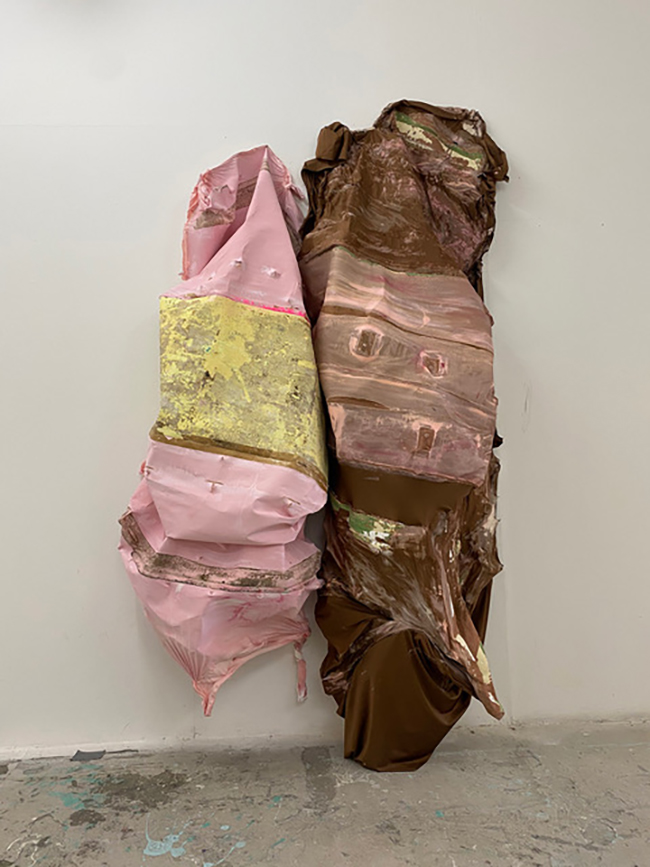Justine Hounam’s artistic journey is rooted in a return to education after spending her earlier years as a single parent. In 2011, she embarked on an Art Foundation course, a pivotal moment that reignited her passion for creativity. She earned a First-Class Honors degree in Fine Art, focusing on sculpture and printmaking, establishing her presence in the London art scene. Hounam’s dedication to refining her craft led her to the Bomb Factory in Islington, where she honed her practice and had her first solo exhibition. Her work captured the attention of Anthony Gormley’s foundation, which awarded her a scholarship to pursue a Master of Fine Arts at Central Saint Martins (CSM), University of the Arts London (UAL). She graduated with another First-Class degree, signaling a significant chapter in her career.

At CSM, Hounam refined her approach to sculpture, particularly focusing on the concept of casting everyday objects with fabric and household paint. This method allowed her to explore the physicality of materials in new and unexpected ways. By layering paint over fabric stretched over furniture like desks and tables, Hounam creates what she describes as “bodily sculptural forms.” Once the fabric is peeled away, it retains an imprint of the object, evoking a sense of skin removed from a body. These sculptures, like “Desk” and “Table,” present as hardened shells, revealing the contours and textures of the objects beneath. The imprint captures the history and aging of these domestic items, transforming the familiar into something abstract yet strangely intimate.
Her work is often described as suggestive of territory, exploring the boundaries between the personal and the object. The use of household items and materials like paint and fabric brings an element of the everyday into her practice, grounding her sculptures in the reality of domestic spaces while simultaneously elevating them into the realm of art. This interplay between the ordinary and the artistic is a central theme in Hounam’s work, as she continues to blur the lines between what is functional and what is sculptural.
In addition to her sculptural work, Hounam has incorporated filmmaking into her practice, adding another layer to the narratives she creates through her art. This multidisciplinary approach reflects her desire to explore different ways of storytelling, whether through the tactile imprints of her sculptures or the visual medium of film. The combination of these elements allows her to create works that are not only visually striking but also conceptually rich, inviting viewers to consider the relationships between objects, spaces, and the body.
Outside of her personal practice, Hounam is also committed to supporting other artists. She runs BOTH Gallery, a non-profit art gallery and project space, where she provides a platform for emerging and established artists to exhibit their work. This endeavor speaks to her dedication to fostering a sense of community within the art world, as well as her belief in the importance of giving back to the creative ecosystem.
In her role as a part-time lecturer, Hounam shares her knowledge and experience with students, helping to shape the next generation of artists. Teaching allows her to engage with fresh perspectives and ideas, which in turn informs her own practice. It’s clear that Hounam values the exchange of ideas and the opportunity to continually learn from others, whether through her work at the gallery or in the classroom.
The way Hounam works with materials is integral to her artistic identity. By casting furniture in fabric and paint, she creates sculptures that act as imprints of the past, capturing the wear and tear of objects that have been used and lived with. This process of casting also speaks to the idea of memory, as the imprints serve as a record of the objects they once enveloped. In this way, Hounam’s work is not just about the objects themselves but also about the histories and stories they carry.
Her approach to sculpture reflects a deep engagement with the physical world, as well as a curiosity about how objects relate to the human experience. The furniture she uses in her sculptures is not just furniture—it is imbued with a sense of life, of having been touched and used by people over time. By casting these objects, Hounam preserves a moment in their existence, turning them into relics of a domestic past.
In her ongoing exploration of materiality, form, and the domestic sphere, Hounam continues to push the boundaries of what sculpture can be. Whether through her innovative use of everyday materials or her commitment to creating spaces for artistic dialogue, she is an artist whose work resonates with a quiet yet profound intensity. Her practice, grounded in personal experience and experimentation, offers a unique perspective on the relationships between people, objects, and space.

